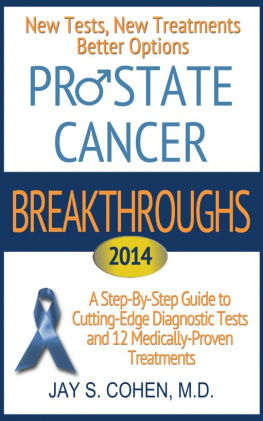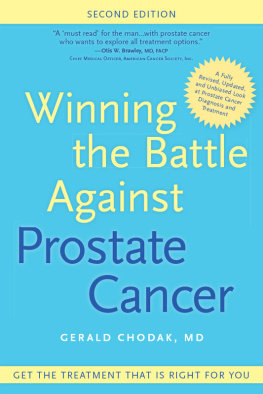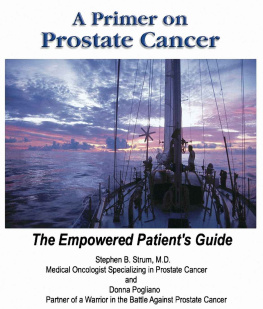Redefining
Prostate Cancer
Why One Size Does Not Fit All
Steven Lamm, MD, Herbert Lepor, MD,
and Dan Sperling, MD

SpryPublishing
ideas to life
Copyright 2013 Spry Publishing LLC
All rights reserved under International and Pan American Copyright Conventions.
No part of this book may be reproduced or transmitted in any form or by any means electronic or mechanical including photocopying, recording, or by any information storage and retrieval system, without permission in writing from the publisher.
This edition is published by
Spry Publishing LLC
2500 South State Street
Ann Arbor, MI 48104 USA
10 9 8 7 6 5 4 3 2 1
Library of Congress Control Number: 2013937938
eBook ISBN: 978-1-938170-32-4
Illustrations by Robin Hite
Privacy: Some names and identifying details have been changed to protect the privacy of individuals.
Disclaimer: Spry Publishing LLC does not assume responsibility for the contents or opinions expressed herein. Although every precaution is taken to ensure that information is accurate as of the date of publication, differences of opinion exist. The opinions expressed herein are those of the author and do not necessarily reflect the views of the publisher. The information contained in this book is not intended to replace professional advisement of an individuals doctor prior to beginning or changing an individuals course of treatment.
To my father, Dr. Arnold Lam, who impressed upon me that one size does not fit all when treating patients. SL
To my wife, Ellen Shapiro, MD, who over the past 31 years has been my best friend as we navigated our personal and professional lives together, and to my exceptionally talented and wonderful children, Abbey and Lauren, who one day may take over for Mommy and Daddy practicing the art and noble profession of medicine. HL
To my father and mother, Dr. Arnold and Joyce Sperling, my wife Eve, and sons Ryan and Evan for all their love, support, and guidance, and to the patients whom I have been privileged to meet and who have inspired me to dedicate myself to fighting prostate cancer. DS
Contents
I n 2011, the U.S. Preventive Services Task Force (USPSTF)an independent organization of medical experts in disease prevention and evidence-based medicineissued new recommendations on prostate cancer screening that threw the world of urology and mens health into a tailspin. After examining all the available clinical research, the USPSTF reversed previous recommendations for prostate-specific antigen (PSA) prostate cancer screening. The organization stated that utilizing the PSA test resulted in little to no improvement in the prostate cancer death rate, while at the same time carrying with it a large percentage of false-positive results that were responsible for unnecessary and potentially harmful evaluation and treatments in many men. In short, universal PSA screening was doing more harm than good.
On the face of it, this recommendation is understandable. PSA screening is an imperfect test, known for a wide margin of false-positive and false-negative results. Many diagnostic and treatment procedures for prostate cancer result in erectile dysfunction, incontinence, and other health problems. Better screening tests are certainly needed, and researchers continue to seek out new, more reliable markers for prostate cancer detection and risk stratification.
But at the same time, the cold hard facts are that PSA screening is currently the best widely available test we have at our disposal for early detection of prostate cancer and PSA screening has resulted in a 40% decline in the death rate from prostate cancer. If we abandon the PSA screening test for men over 50, what can we do to detect the most common cancer in men that kills an American male every eight minutes? Should we summarily disregard this test for all men recognizing that many lives are saved by early detection and curative intervention?
The most sensible answer seems to be to get smarter about how we apply the PSA test. An active 55-year-old man who has a strong family history of prostate cancer is likely a better candidate for PSA screening than a frail 85-year-old. While we wait for a better gold standard test, we should not hold back from using PSA screening for men who can benefit from it. If you are a patient, you deserve a say in this decision. Have a discussion with your doctor about the pros and cons of PSA testing in your particular situation.
We are also living in an exciting time for prostate cancer diagnosis and treatment. As youll read in this book, there are promising and innovative new techniques for evaluating and treating cancer in the prostate that may control the disease while avoiding many of the grievous side effects.
The three of us come from very different areas of medicine. Dr. Lamm is an internist and mens health specialist who meets men at the beginning of their prostate cancer journey. Dr. Lepor is a leading urologist and researcher who codeveloped the nerve-sparing radical prostatectomy and has performed thousands of prostate cancer surgeries. And Dr. Sperling is an interventional radiologist specializing in advanced imaging techniques for the prostate and cutting-edge new forms of minimally invasive treatment. We have found that, by working together, we can offer our patients a collaborative care approach that results in the best individual treatment for them.
Above all, we recognize that just as every prostate cancer is different, every man who receives this diagnosis has very different needs and expectations. Age, medical history, family situation, occupation, emotional needsall of these are factors in finding the treatment approach that is right for you. What is a good choice for one man may be completely wrong for another, even if they have a very similar type and grade of prostate cancer. One size fits all treatments are the past, not the future, of prostate cancer care.
We have written Redefining Prostate Cancer with this in mind. In these pages, men and their loved ones will find answers to their prostate cancer questions, from diagnosis through treatment and beyond. It is the most up-to-date review on genetic markers for risk stratification, imaging, and focal therapy currently available for prostate cancer patients. And through the stories of patients just like you, youll learn how men from all walks of life have found health and improved quality of life in the course of their prostate cancer journey.
One Mans Story
J ohn is a 58-year-old man who hasnt been inside a doctors office in more than 15 years. His wife Denise made an appointment for him with Dr. Lamm for a routine physical and he agreed, although he feels fine. A little tired, sure, but hes not as young as he used to be. And, he works long hours at a demanding job and cant always get enough sleep. Hes mainly visiting the doctor to set his wifes mind at rest.
For her part, Denise worries that her husband may not be as healthy as he seems to think he is. As they start planning for his upcoming early retirement, shes finally gotten him to agree to a checkup just to make sure everything is working right. Shes also noticed that John tires easily and isnt as interested in sex as he used to be. Denise worries that his lack of stamina could be a sign of a health problem, a thought she doesnt share with her husband.
Men such as John often attribute real health problems to aging. Its important to determine if there is a deteriorating quality of life issue. So Dr. Lamm asks him key questions about his daily health now as compared to 10 or 20 years ago. What is his energy level? Does he exercise and, if so, how much can he tolerate? Are his interest in sex and level of sexual performance the same?









